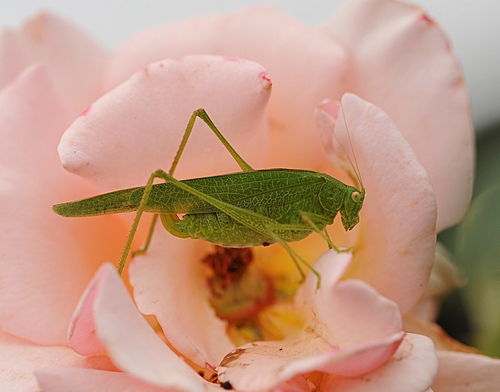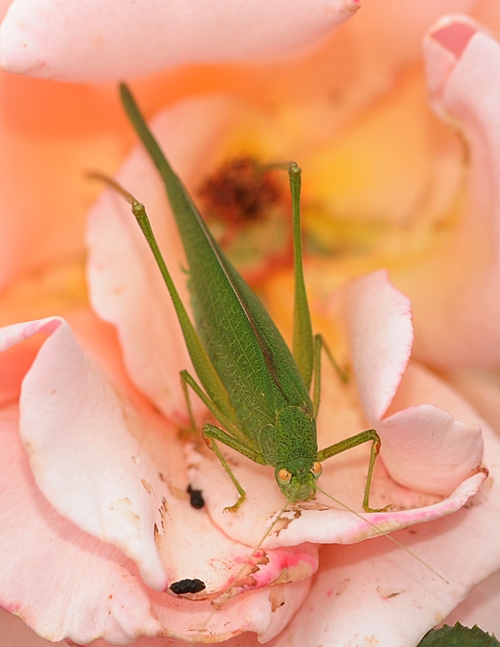- Author: Kathy Keatley Garvey
Collembola! Watch the springtails spring!
Over the last several days, Art Shapiro, professor of evolution and ecology at the University of Caifornia, Davis, has patrolled a UC Davis sidewalk checking out a huge volume of springtails.
"Literally millions of little buff-colored springtails," he related Monday, "have been swarming for the past three days on the sidewalk and adjacent strip under the oak trees on the east side of Howard Way, about halfway between the parking garage and Russell Boulevard, mostly around 7 to 8 a.m. and after 5 p.m. I've never seen such numbers, except for the snow springtails in winter in upstate New York."
I trekked over to Howard Way at 7 a.m. today and it took awhile to find these little buff-colored organisms. That's because they're oh, so tiny! They're less than six millimeters long--that's 0.24 inches in length. And they move fast.
Obviously, Art Shapiro has the eyes of an eagle. I don't.
Springtails (order Collembola) are those primitive, wingless six-legged critters you find in soil, leaf litter, decaying wood and other damp places. Basically, they're known for working the soil. However, some springtails, such as Sminthurus viridis, are agricultural crop pests.
Why are they called springtails? Retired UC Berkeley entomologist Jerry Powell writes in California Insects (a University of California Press book co-authored by entomologist Charles Hogue): "Most springtails are readily recognizable by a forked, tail-like appendage (furcula) which arises toward the rear of the abdomen and which the insect snaps against the substratum, springing itself into the air."
California has about 130 species that spring themselves into the air.
Frankly, it's a wonder anyone can see them, springing or not springing.
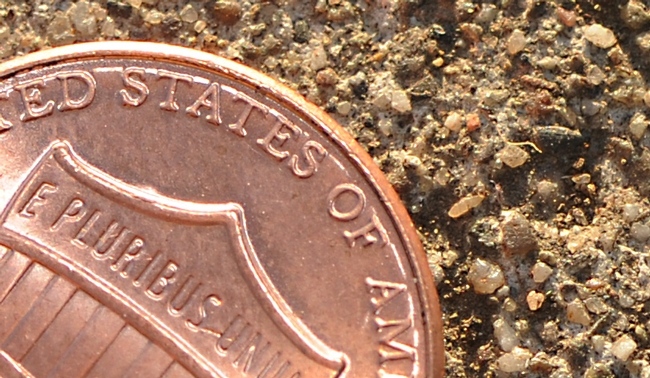
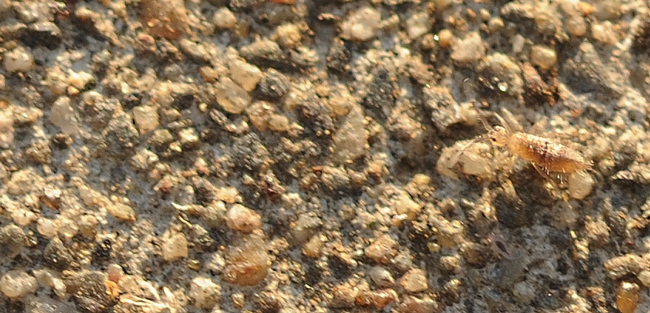

- Author: Kathy Keatley Garvey
Exciting news!
Scientists based at the University of California, San Francisco, have discovered four new honey bee viruses.
Their research, published today in the international Public Library of Science (PLoS) journal, documents what they found in a 10-month study of healthy, commerically managed honey bee colonies.
One virus, the newly named Lake Sinai virus strain 2 (LSV2), predominated. “In fact, we found more than 1 billion LSV2 viral genomes (an approximation of actual viruses) per honey bee in some of the colonies,” said insect virus researcher Michelle Flenniken, a postdoctoral fellow in the Raul Andino lab at UC San Francisco and the Häagen-Dazs Postdoctoral Fellow in Honey Bee Biology at UC Davis.
The virus strain is one of two Lake Sinai strains found among the 431 samples the scientists collected. Both replicate in honey bees, Flenniken said.
Flenniken is part of a seven-member team from the Raul Andino and Joseph DeRisi labs at UC San Francisco that today published “Temporal Analysis of the Honey Bee Microbiome Reveals Four Novel Viruses and Seasonal Prevalence of Known Viruses, Nosema, and Crithidia" in PLOS.
The research, Flenniken said, provides “a baseline for future epidemiological studies aimed at understanding current and emerging threats to honey bees and determining the causes of the declining bee population."
That it does.
"Michelle Flenniken is particularly adroit at explaining these findings and techniques to academic audiences and the general public," said Extension apiculturist Eric Mussen of the UC Davis Department of Entomology faculty. Mussen was not involved with the research.
Knowing that numerous viruses, microbes and mites threaten honey bee colony health, the researchers set out to answer the question: “What is normal microbial flora (virus, bacteria, fungi) associated with honey bee colonies over the course of a year?”
They used cutting-edge technology to document the seasonal incidence and abundance of previously characterized viruses. Their broad-scale analysis incorporated a suite of molecular tools: custom microarray, polymerase chain reaction (PCR), quantitative PCR (qPCR) and deep sequencing. Their work enabled rapid detection of the presence—or absence—of all previously identified honey bee pathogens and facilitated the detection of the four novel pathogens.
The research was primarily funded by Project Apis m., (PAm), a Chico-based non-profit organization established in 2006 by beekeepers and orchardists to fund honey bee research on managed colonies. PAm, headed by executive director Christi Heintz, brings together representatives of the American Honey Producers Association, the American Beekeeping Federation, the National Honey Board, California State Beekeepers Association, and California almond farmers.
This research is all the buzz among beekeepers today, as well it should be--or "bee." (Read more about their work and see photos on the UC San Francisco website and on the UC Davis website.)
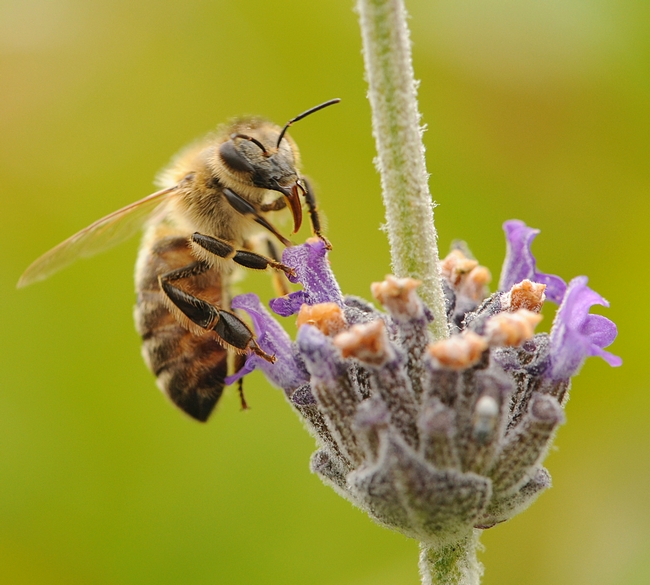
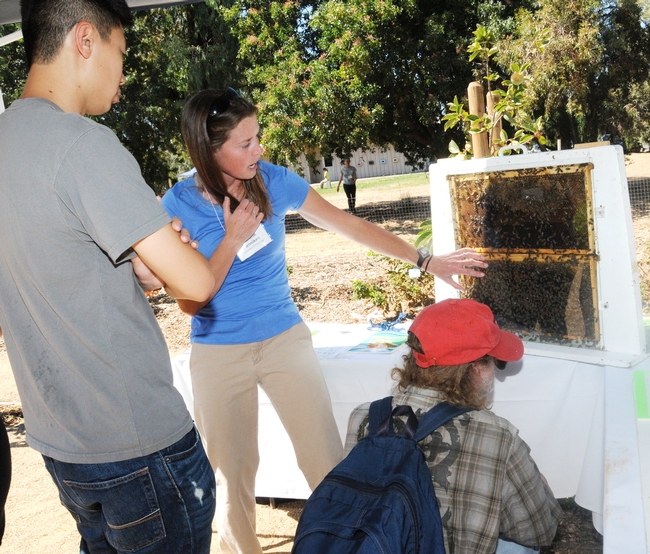
- Author: Kathy Keatley Garvey
Emcee Tom Turpin of Purdue University stood at the podium and acknowledged he might mispronounce an entomology student's name. "If it sounds anything like your name and I’m looking at you, that’s you."
So began the Linnaean Games, a college-bowl type competition that's as lively as it is entertaining and educational.
And it's all about insects, entomologists and entomological facts.
The Linnaean Games, held at the annual Entomological Society of America (ESA) meeting, is an event that pits student-teams against one another until a winner is declared. The 2010 event, hosted in San Diego, ended with Ohio State University winning the championship.
Students buzz in with the answers to questions such as:
What’s the loudest insect in the world? What is the egg case of a cockroach called? Kissing bugs, in the family Reduviidae, are vectors of what disease? About how long have insects been on earth? Give three official common names for Helicoverpa zea.
Ohio State defeated UC Davis, Pennsylvania State University and the University of Georgia and finally, in the championship game, toppled the University of Nebraska.
But first, the Ohio team of Joshua Bryant, Glene Mynhardt, Kaitlin Uppstrom and Nicola Gallagher had to get by the UC Davis team of Meredith Cenzer, Matan Shelomi, Andrew Merwin, and Ralph Washington.
As the crowd cheered them on, the two teams tied the score several times. Finally, with the score knotted at 90-90, Ohio correctly answered the final question to advance to the next round.
Tom Turpin of Purdue emceed the program while a trio of judges--J. E. McPherson of Southern Illinois University, Carol Annelli of Washington State University and Susan Weller of the University of Minnesota--scored the answers.
Each ESA branch sponsors a Linnaean Games competition and sends up to two teams to the nationals.
Pacific Branch sent UC Davis and Washington State University.
Southeastern Branch: University of Georgia and University of Florida
Eastern Branch: Pennsylvania State University (University of Maryland also won at the branch level but did not participate in the nationals)
North Central Branch: Ohio State University and the University of Nebraska
Southwestern Branch: New Mexico State and Texas A&M
Answers to the above questions (see sixth paragraph):
Question:
What’s the loudest insect in the world?
Answer:
African cicada (Brevisana brevis); it has been measured at 106 decibels, (equivalent to a gas mower at 3 feet away).
Question:
What is the egg case of a cockroach called?
Answer:
Ootheca.
Question:
Kissing bugs, in the family Reduviidae, are vectors of what disease? Answer:
Chagas disease
Question:
About how long have insects been on earth?
Answer:
Some 400-380 million years ago.
Question:
Give three official common names for Helicoverpa zea?
Answer:
Corn earworm, tomato fruitworm, and cotton bollworm
Other questions and answers included:
Question:
Which sexes of cicadas have tymbals and which have tympana?
Answer:
Males have both. Females have only tympana.
Question:
What term is used to describe the antennae found on male mosquitoes? Answer:
Plumrose
Question:
Crickets are well-known music makers. What are the names of the two specialized structures that allow them to make that wonderful noise and where specifically on the body are they located?
Answer:
File and scraper, located on the forewings.
Question:
At what American school was the first entomology class taught and who was the teacher?
Answer:
Harvard (1805-1822) W.D. Peck.
Question:
In the Amazon rain forest, what are the common names of two groups of insects that make up about 1/3 of the biomass of all animals in the habitat?
Answer:
Ants and termites.
Question:
Problems with honey bee hives in what state led to the recognition of colony collapse disorder?
Answer:
Pennsylvania
Question:
Name two orders of insects that are entirely predatory.
Answer:
Odonata and Mantodea
Question:
The monarch is actually the second-most popular state insect. What insect is the most frequently adopted state insect?
Answer:
Honey bee.
Question:
Robert Frost wrote a poem that begins with the lines: “An ant on a table cloth ran into a dormant moth of many times his size.” As you might guess the poem is about ants. What is the title of the poem?
Answer:
Departmental
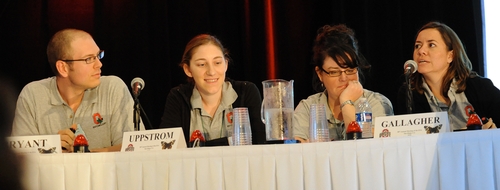
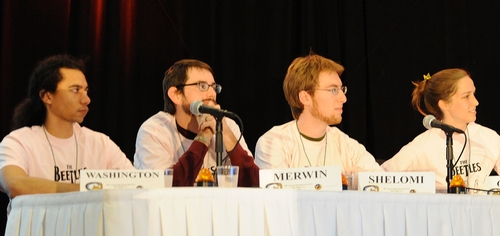
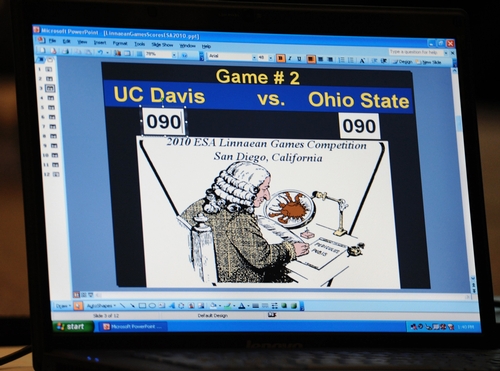
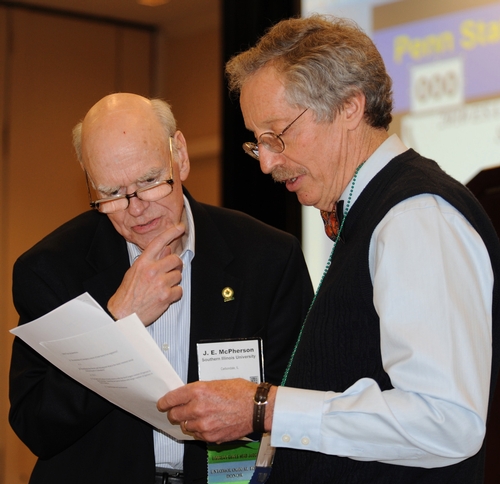
- Author: Kathy Keatley Garvey
It's the kind of rose garden that Joe South would write about.
The Grammy-award winning songwriter-guitarist who wrote "I Never Promised You a Rose Garden" (popularized by country singer Lynn Anderson), has probably never seen this rose garden, though.
It's at the University of California, Davis, and it's an All-America Rose Selections (AARS) Test Garden.
Located on Hopkins Road, off Hutchison Drive, just west of the central UC Davis campus, it is one of 15 AARS test gardens located throughout the United States, representing a variety of climates. In fact, the UC Davis rose garden is one of three test gardens in California--the others are in Carlsbad and San Jose.
AARS, a self-described "non-profit association dedicated to the introduction and promotion of exceptional roses that will be easy to grow and require minimal care," selects and plants roses that have the potential to become a new variety.
"We use common practices for optimal growth and insect control but no fungicides for control of powdery mildew or dust in order to evaluate natural disease resistance," according to a sign posted at the entrance.
It is indeed an exceptional garden, filled with 30 new rose varieties, including hybrid teas, floribundas, landscape, grandifloras and one climbing rose.
The insects there would agree, too: the honey bees, ladybugs, katydids, and spotted cucumber beetles. The honey bees and ladybugs are beneficial; the katydids and spotted cucumber beetles are pests.
It wasn't planted for them, but it's theirs, too.
"I beg your pardon--I never promised you a rose garden.
Along with the sunshine there's gotta be a little rain sometime..."
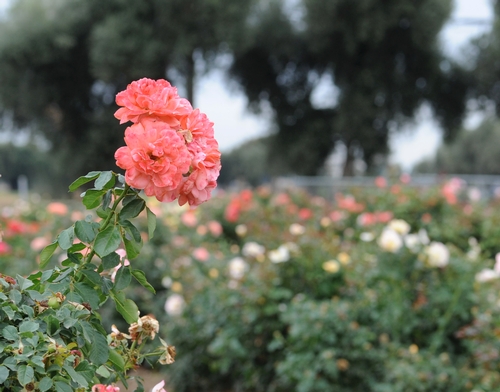


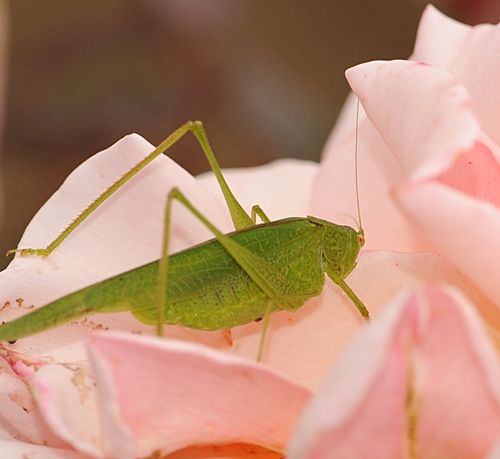

- Author: Kathy Keatley Garvey

Its stance is firm. Its eyes glow menacingly. Its attitude: "Don't mess with me."
We spotted this katydid on a rose in a UC Davis rose garden. It towered over the honey bees, spotted cucumber beetles, ladybugs, hover flies, and assorted other insects.
The katydid, in the family Tettigonlidae, is also known as a long-horned grasshopper, but entomologists point out it's more closely related to crickets than grasshoppers.
Tettigoniids dine on flowers, leaves, bark and seed, and some feed on other insects.
Now if the katydid were six feet tall...that would scare any trick-or-treater...
